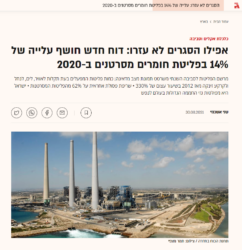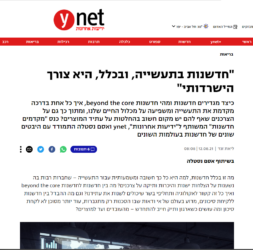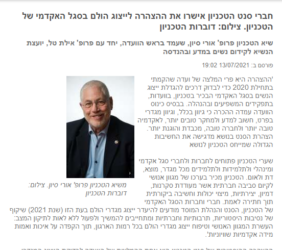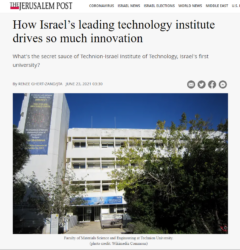Connect to schedule an interview
+972.4.829.2329
Neaman in the media
Same as two Covid-19 crises a year, every year
Head of Environment & Energy Cluster at Samuel Neaman Institute and a senior researcher at the University of Haifa Prof. Ofira Ayalon, who headed the Israeli Climate Change Information Center, tells TheMarker magazine that the damage caused by climate change so far is so extensive that it cannot be quantified.
Even quarantine didn’t help: a new report reveals a 14% increase in carcinogenic emissions in 2020
As part of the National Emissions Report (iPRTR), a chapter was devoted to the issue of methane.
In this section, an international review of studies on methane emissions, conducted by Samuel Neaman Institute at the Technion for the Ministry of Environmental Protection,
found that the average volume of methane emissions from production is 0.5%-3%.
Data obtained from this year, indicate that the volume of methane emissions are much higher than what is known so far
Link to the Full Article on Globes
Only two weeks after declaring a war on violence – 8 victims in Arab society
Benet and Bar-Lev launched a new police department to fight the crime in Arab society while it seems that there is no patience left there, even among those living in mixed cities.
A survey published last week by the Avraham Initiatives Association and the Samuel Neaman Institute at the Technion shows that in mixed cities, the fear of violence is greater than in the Arab cities
Innovation in the industry, and in general, is a survival need
What is the connection between cars, meat, and the environmental protection? Innovation.
Prof. Ofira Ayalon, explains that these industries, understood the top-down regulation requirements and the bottom-up consumers’ requirements, and decided to suggest ways to reduce their environmental impact. Some are Green-wash, and some are indeed essential to the company’s activities and help reduce the harmful effects.
New Carbon Tax, and what about methane emissions?
The new Carbon Tax that was approved this week by the government offices, does not consider the methane emissions claiming they are “very low”.
Research from Samuel Neaman Institute at the Technion claims differently and sets there are not enough reliable data to decide the real methane emissions in Israel.
The systems for integrating renewable energy production and agriculture improved the quality of French wine. And in Israel?
Gershon Grossman, Naama Shapira
Despite the ambitious goal of switching to renewable energy, regulation in Israel currently allows the construction of agrivoltaics systems intended for “dual use”, a combination of agriculture and renewable energy production, only in reservoirsand on greenhouse roofs.
It seems like the government rushes towards a revolution in education this year – without computers, teachers, or budget
Leading education systems in the world that have succeeded in improving student achievement have done so through comprehensive reforms that have focused on a variety of educational aspects – from a research written by Dr. Eli Eisenberg and Ayelet Raveh from Samuel Neaman Institute at the Technion
The members of Technion’s Senate approved the statement on fair representation in the Technion’s academic faculty.
The statement follows the recommendation given by a committee established by Technion’s president Prof. Uri Sivan early in 2020, to examine ways to increase women representation in the Technion’s Academic faculty, committees, decision making and management.
Prof. Irad Yavneh Director of Samuel Neaman Institute and Prof. Orit Hazzan, senior researcher in Samuel Neaman Institute were part of this initiative as committee members.
This is the secret to how Israel’s leading technology institute manages to drive so much innovation.
This article presents the new book written by Prof. Shlomo Maital and Rafi Nave: “Aspiration, Inspiration, Perspiration: How Technion Faculty and Graduates Fuse Creativity and Technology to Change the World.”
Together they spent much of the COVID year conducting interviews via Zoom with more than 100 notable Technion graduates asking them about their life journeys, innovations and how it all came about.
Brazil Ranks No. 1 for ‘Aliyah Potential’
Daphne Getz, Ilia Zatcovetsky, Ayelet Raveh
From an article based on research from Ilia Zatcovetsky, Ayelet Raveh and Dr. Daphne Getz:
Brazilian Jews have more reason than ever to leave their country and possess skills very much needed in Israel.










